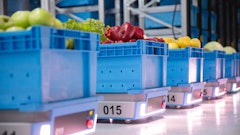
For Sunsweet Growers Inc., the grower-owned cooperative that represents more than one-third of the prune market worldwide, demand forecasting comes with an extra wrinkle.
Because the coop is contractually obligated to purchase 100 percent of the plum harvest supplied by its members, and harvests vary widely in size and quality from year to year, one of Sunsweet's challenges is to forecast both supply and demand simultaneously, in parallel, and then do its best to match up those two sets of quantities in ways that provide the optimal return to its members.
"In years with back-to-back large crops, if you were to keep the demand side stable, we'd have way too much fruit. If we had back-to-back disaster crops and demand was stable, then we'd have tremendous shortages," points out Harold Upton, vice president, strategic business processes.
Sunsweet's challenge in balancing supply and demand, therefore, includes not just forecasting, but also directing supply and shaping demand to a larger degree than most manufacturers.
Before implementing the Zemeter demand planning system from Supply Chain Consultants, Newark, DE, the company forecasted on spreadsheets, using rough numbers that often resulted in an oversupply of product.
"To make sure we never lost shelf space, we tended to err on the side of having too much fruit all the time. But then we'd find ourselves having to move too much product on commodity markets that don't pay the premium we want to pay to our growers," Upton explains.
"One of our objectives was to gain a better understanding of the demand side, not just in terms of where we'd traditionally moved product, but also in terms of where sales were more profitable, and not just in terms of price, but taking into account total cost, including production and distribution costs, all the way through the supply chain to procurement of product.
"So our demand planning model extends all the way to fruit utilization and crop forecasting, and there are a lot of factors that are constantly being changed as the year unfolds."
Upton uses his own models to forecast harvests based on weather and other factors, on both long and short horizons. The short-term supply forecast data is then integrated with Zemeter, which is used to manage the demand side of the equation.
The overall supply and demand picture is set up once a year in Zemeter, Upton notes, and then adjusted monthly, quarterly, and weekly as first the details of the harvest size and quality become more definite, and then production and sales of the year's crop begins.
"On a weekly basis we look at our A and B customers, to see the impact of what they're doing on demand, and then tie that back to our capacity constraints, in terms of both processing and distribution capacity," Upton explains.
The final iteration of the demand plan is fed from Zemeter into a finite scheduler, where projections are broken down into quantities by plant utilization, line and shift.
The coop also uses the system to do longer-term strategic planning as it relates to product utilization, Upton says.
"We play a lot of what-if games. For example, we'll model different ways to use the crop, if it's this size or that size. We can push that out to our SAP system then and run some P&Ls, plus there's some rough costing in Zemeter. Then we can decide, based on a limited supply, if we want to go more after the supermarket channel with a product, or a particular bid opportunity. We can look at different scenarios and see how they'd impact consumption and profitability.
"Sometimes an opportunity looks like it offers a good margin, but if it steals from another product with better margins, because there's only a limited supply of that size fruit, it may not be as attractive after all," Upton points out.

























